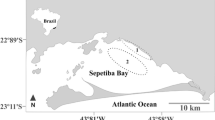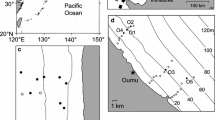Abstract
Resource use diversity occurs when a population is composed of ecologically heterogeneous individuals who use only a subset of the population’s resource availability. The aim of this study was to examine the diet of juveniles, sub-adults and adults of Prionotus punctatus (40 to 190 mm Total Length - TL) to assess the importance of factors driving intraspecific changes, such as spatial differences in the diet or individual body size changes. The intraspecific trophic strategy was also described. We examined the stomach contents of 210 individuals collected in two zones of a tropical bay (outer and inner) grouped into three size classes (< 90 mm TL, juveniles; 90–140 mm TL, subadults; > 140 mm TL, adults). The Prey-Specific Index of Relative Importance (PSIRI) indicated that Peneidae, Amphipoda (excluding Caprellidae), Mysidacea, Teleostei and Copepoda were the most important food items. The change in the diet during fish growth differed between the two bay zones. In the inner zone, the juveniles fed mainly on Copepoda and Amphipoda (excluding Caprellidae), whereas the adults fed mainly on Teleostei and Peneidae. In the outer zone, the juveniles fed mainly on Mysidacea, whereas the adults fed mainly on Peneidae and Brachyura, with Amphipoda (excluding Caprellidae) being an important prey for individuals in all size classes. Significant differences were detected in the diets among size classes (Pseudo-F = 5.52; P = 0.003) but not between the two zones (Pseudo-F = 2.20; P = 0.113) according to PERMANOVA. Niche breadth decreased during ontogeny, and the niche overlap among the size classes was low (<0.60), except for subadults and adults (>0.80) in both zones. Together, these observations suggest that the feeding niche in the larger-sized individuals of this species tends to overlap irrespective of the dietary differences between different areas, which can indicate some degree of narrowing in morphological and behavioural features. The increase in body size rather than spatial dietary differences seems to be a major determinant for intraspecific changes in feeding habits. Therefore, diet partitioning along growth, rather than dietary spatial change, seems to be the main mechanism used by this species to decrease intraspecific competition.




Similar content being viewed by others
References
Amundsen PA, Gabler HM, Staldvik FJ (1996) A new approach to graphical analysis of feeding strategy from stomach contents data – modification of the Costello (1990) method. J Fish Biol 48:607–614. https://doi.org/10.1111/j.1095-8649.1996.tb01455.x
Anderson MJ, Gorley RN, Clarke KR (2008) PERMANOVA+ for PRIMER: Guide to Software and Statistical Methods. Plymouth: PRIMER-E
Araújo FG, Cruz-Filho AG, Azevedo MCC, Santos ACA (1998) Demersal fish community structure of Sepetiba Bay, RJ. Rev Bras Biol 58(3):417–430. https://doi.org/10.1590/S0034-71081998000300007 (in Portuguese)
Araújo FG, Azevedo MCC, Silva MA, Pessanha ALM, Gomes ID, Cruz-Filho AG (2002) Environmental influences on the demersal fish assemblages in the Sepetiba Bay, Brazil. Estuaries 25:441–450. https://doi.org/10.1007/BF02695986
Azevedo MCC, Araújo FG, Pessanha ALM, Silva MA (2006) Co-occurrence of demersal fishes in a tropical bay in southeastern Brazil: a null model analysis. Estuar Coast Shelf Sci 66(1–2):315–322. https://doi.org/10.1016/j.ecss.2005.09.006
Bardach JE, Case J (1965) Sensory capabilities of the modifred fms of squirrel hake (Urophycis chues) and searobins (Prionotus carolinis and P. evolans). Copeia 1965(2):194–206. https://doi.org/10.2307/1440724
Bolnick DI, Svanback R, Fordyce JA, Yang LH, Davis JM, Hulsey CD, Forister ML (2003) The ecology of individuals: incidence and implications of individual specialization. Amer Nat 161:1–28 https://www.jstor.org/stable/10.1086/343878
Braga FMS, Braga MAS (1987) Study of the feeding habit of Prionotus punctatus (Bloch, 1797) (Teleostei, Triglidae) in the region of Ilha de Anchieta, São Paulo state, Brazil. Rev Bras Biol 42(1/2):31–36 (in Portuguese)
Brown SC, Bizzarro JJ, Cailliet GM, Ebert DA (2012) Breaking with tradition: redefining measures for diet description with a case study of the Aleutian skate Bathyraja aleutica (Gilbert 1896). Environ Biol Fish 95:3–20. https://doi.org/10.1007/s10641-011-9959-z
Clarke KR, Gorley RN (2015) PRIMER v7: User Manual/Tutorial. Plymouth: PRIMER-E
Colwell RK, Fuentes ER (1975) Experimental studies of the niche. Annu Rev Ecol Syst 6(1):281–310. https://doi.org/10.1146/annurev.es.06.110175.001433
Costello MJ (1990) Predator feeding strategy and prey importance: a new graphical analysis. J Fish Biol 36:261–263. https://doi.org/10.1111/j.1095-8649.1990.tb05601.x
Cunha CLN, Rosmam PCC, Ferreira AP, Monteiro TCN (2006) Hydrodynamics and water quality models applied to Sepetiba Bay. Cont Shelf Res 26:1940–1953. https://doi.org/10.1016/j.csr.2006.06.010
Day JW, Hall CAS, Kemp WM, Yáñez-Arancibia A (1989) Estuarine Ecology. New York, John Wiley and Sons. 558p
Elliott M, Hemingway KL, Costello MJ, Duhamed S, Hostens K, Labropoulou M, Marshall S, Winkler H (2002) Links between fish and other trophic levels. In: Elliott M, Hemingway KL (eds) Fishes in estuaries. Blackwell Science, Oxford, pp 124–216
Fretwell SD, Lucas HL Jr (1970) On territorial behaviour and other factors influencing habitat distribution in birds. I. Theoretical development. Acta Biotheor 19:16–36. https://doi.org/10.1007/BF01601954
Guedes APP, Araújo FG, Pessanha ALM, Milagre RR (2015) Partitioning of the feeding niche along spatial, seasonal and size dimensions by the fish community in a tropical bay in southeastern Brazil. Mar Ecol 36(1):1–19. https://doi.org/10.1111/maec.12115
Hinz H, Kaiser MJ, Bergmann M, Rogers SI, Armstrong MJ (2003) Ecological relevance of temporal stability in regional fish catches. J Fish Biol 63:1219–1234. https://doi.org/10.1046/j.1095-8649.2003.00244.x
Hossain MA, Hemraj DA, Ye Q, Leterme SC, Qin JG (2017) Diet overlap and resource partitioning among three forage fish species in Coorong, the largest inverse estuary in Australia. Environ Biol Fish 100:639–654. https://doi.org/10.1007/s10641-017-0592-3
Jackson AC, Rundle SD, Attrill MI, Cotton PA (2004) Ontogenetic changes in metabolism may determine diet shifts for a sit-and-wait predator. J Anim Ecol 73:536–545. https://doi.org/10.1111/j.0021-8790.2004.00831.x
Krebs CJ (1999) Ecological methodology. 2nd ed. San Francisco, Benjamin/Cummings ISBN-13: 978–0321021731
Krumme U (2009) Diel and tidal movements by fish and decapods linking tropical coastal ecosystems. In: Nagelkerken I (ed) Ecological connectivity among tropical coastal ecosystems. Springer, Dordrecht. https://doi.org/10.1007/978-90-481-2406-0_8
Labropoulou M, Eleftheriou A (1997) The foraging ecology of two pairs of congeneric demersal fish species: importance of morphological characteristics in prey selection. J Fish Biol 50:324–340. https://doi.org/10.1111/j.1095-8649.1997.tb01361.x
Litz MNC, Miller JA, Copeman LA, Teel DJ, Weitkamp LA, Daly EA, Claiborne AM (2017) Ontogenetic shifts in the diets of juvenile Chinook Salmon: new insight from stable isotopes and fatty acids. Environ Biol Fish 100:337–360. https://doi.org/10.1007/s10641-016-0542-5
MacArthur RH, Pianka ER (1966) On optimal use of a patchy environment. Amer Nat 100:603–609 http://www.jstor.org/stable/2459298
Magro M, Cergole MC, Rossi-Wongtschowski CLDB (2000) Synthesis of knowledge of the main potentially exploitable coastal fisheries resources on the south-east coast of Brazil: Fish. No. 639.22 MAG, MMA, Ministry of the Environment, Water Resources and Legal Amazon. (in Portuguese)
McBride RS, Able KW (1994) Reproductive seasonality distribution and abundance of Prionotus carolinus and P. evolans (Pisces: Triglidae) in the New York bight. Estuar Coast Shelf Sci 38:173–188. https://doi.org/10.1006/ecss.1994.1011
Medeiros APM, Xavier JH de A, Rosa IM de L (2017) Diet and trophic organization of the fish assemblage from the Mamanguape River estuary, Brazil. Lat Am J Aquat Res 45(5):879–890. https://doi.org/10.3856/vol45-issue5-fulltext-2
Milagre RR, Azevedo MCC, Araújo FG (2002) Distribution, reproduction and feeding habits of Prionotus punctatus (Scorpaeniformes: Triglidae) in Sepetiba Bay, RJ. Acta Biol Leopoldensia 24(2):173–184 (in Portuguese)
Mittelbach GG, Osenberg CW (1993) Stage-structured interactions in bluegill: consequences of adult resource variation. Ecology 74(8):2381–2394. https://doi.org/10.2307/1939589
Muto EY, Corbisier TN, Coelho LI, Arantes LPL, Chalom A, Soares LS (2014) Trophic groups of demersal fish of Santos Bay and adjacent continental shelf, São Paulo state, Brazil: temporal and spatial comparisons. Braz J Oceanogr 62(2):89–102. https://doi.org/10.1590/S1679-87592014045906202
Pereira HH, Neves LM, Costa MR, Araújo FG (2015) Fish assemblage structure on sandy beaches with different anthropogenic influences and proximity of spawning grounds. Mar Ecol 36(1):16–27. https://doi.org/10.1111/maec.12113
Pessanha ALM, Araújo FG (2014) Shifts of the feeding niche along the size dimension of three juvenile fish species in a tidal mudflat in southeastern Brazil. Mar Biol 161:543–550. https://doi.org/10.1007/s00227-013-2356-8
Pianka ER (1982) Evolutionary ecology. New York, Harper and Row. 416p. ISSN: 0269-7653
Platell ME, Sarre GA, Potter IC (1997) The diets of two co-occurring marine teleosts, Parequula melbournensis and Pseudocaranx wright, and their relationships to body size and mouth morphology, and season and location of capture. Environ Biol Fish 49:361–376. https://doi.org/10.1023/A:1007388200920
Potter IC, Tweedley JR, Elliott M, Whitfield AK (2015) The ways in which fish use estuaries: a refinement and expansion of the guild approach. Fish Fish 16:230–239. https://doi.org/10.1111/faf.12050
Ross ST (1986) Resource partitioning in fish assemblages: a review of field studies. Copeia 1986:352–388. https://doi.org/10.2307/1444996
São Clemente RRB, Costa PAS, Martins AS (2014) Distribution and feeding habits of three sea robin species (Bellator brachychir, Prionotus nudigula and Prionotus punctatus) in the Campos Basin, southeastern Brazil. Lat Am J Aquat Res 42(3):488–496. https://doi.org/10.3856/vol42-issue3-fulltext-9
Scharf FS, Juanes F, Rountree RA (2000) Predator size - prey size relationships of marine fish predators: interspecific variation and effects of ontogeny and body size on trophic-niche breadth. Mar Ecol Prog Ser 208:229–248. https://doi.org/10.3354/meps208229
Schmitter-Soto JJ, Castro-Aguirre JL (1996) Trophic comparison among Triglidae (Pisces: Scorpaeniformes) of Baja California Sur. Mexico Rev Biol Trop 44(2):803–811 http://hdl.handle.net/10669/25976
Soares LSH, Apelbaum R (1994) Daily food activity of Prionotus punctatus (Teleostel: Triglidae) of the Ubatuba coast, Brazil. Bol Inst Oceanogr 42(1/2):85–98. https://doi.org/10.1590/S0373-55241994000100007 (in Portuguese)
Sogard SM (1997) Size-selective mortality in the juvenile stage of teleost fishes: a review. Bull Mar Sci 60(3):1129–1157 https://www.researchgate.net/publication/233490993
Svanbäck R, Bolnick D (2007) Intraspecific competition drives increased resource use diversity within a natural population. Proc R Soc Lond B Biol Sci 274:839–844. https://doi.org/10.1098/rspb.2006.0198
Teixeira RL, Haimovici M (1989) Distribution, reproduction and feeding habits of Prionotus punctatus and P. nudigula (Pisces: Triglidae) on the coast of Rio Grande do Sul, Brazil. Atlântica 11(1):13–45 (in Portuguese)
Ward AJW, Webster MM, Hart PJB (2006) Intraspecific food competition in fishes. Fish Fish 7:231–261. https://doi.org/10.1111/j.1467-2979.2006.00224.x
Werner EE, Gilliam JF (1984) The ontogenetic niche and species interactions in size-structured populations. Annu Rev Ecol Evol Syst 15:393–425. https://doi.org/10.1146/annurev.es.15.110184.002141
Wootton RG (1991) Ecology of teleost fishes. Chapman & Hall, London 404p https://www.springer.com/us/book/9780412845901
Acknowledgements
We thank technicians of the Laboratory of Fish Ecology, Universidade Federal Rural do Rio de Janeiro for their help in fieldwork. This study was partially financed by the Brazilian National Counsel for Research Development (CNPq), Process number 302555/2008-0. This research was conducted under SISBIO Collection of Species Permit number 10707 issued by ICMBio, Brazilian Environmental Agency.
Author information
Authors and Affiliations
Corresponding author
Additional information
Publisher’s Note
Springer Nature remains neutral with regard to jurisdictional claims in published maps and institutional affiliations.
Rights and permissions
About this article
Cite this article
Andrade-Tubino, M.F., Milagre, R.R. & Araújo, F.G. What matters for intraspecific diet changes: the dietary differences between different areas or the increase in body size? The case of the searobin Prionotus punctatus in a tropical bay. Environ Biol Fish 102, 467–477 (2019). https://doi.org/10.1007/s10641-019-0843-6
Received:
Accepted:
Published:
Issue Date:
DOI: https://doi.org/10.1007/s10641-019-0843-6




